What Kind of Spectrum Do Astronomers Find Most Useful Emission Absorption Normal Continuous
Types of Astronomical Spectra
Different celestial objects produce different types of spectra. The spectrum of an object is one means of identifying what type of object it is. How different spectra arise is shown in the schematic diagram below.
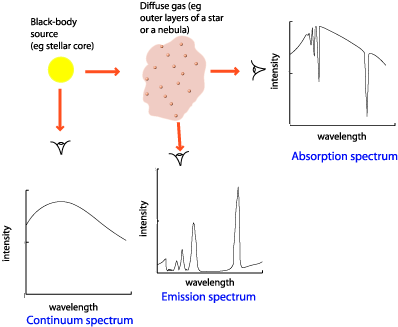
Credit: Adapted from a diagram by James B. Kaler, in "Stars and their Spectra," Cambridge University Press, 1989.
Figure 1: How continuous, emission and absorption spectra can be produced from same source.
Continuum spectrum: In this diagram, a dense hot object such as the core of a star acts like a black body radiator. If we were able to view the light from this source directly without any intervening matter then the resultant spectrum would appear to be a continuum as shown bottom left in the Figure 1 above.
Absorption spectrum: Most stars are surrounded by outer layers of gas that are less dense than the core. The photons emitted from the core cover all frequencies (and energies). Photons of specific frequency can be absorbed by electrons in the diffuse outer layer of gas, causing the electron to change energy levels. Eventually the electron will de-excite and jump down to a lower energy level, emitting a new photon of specific frequency. The direction of this re-emission however is random so the chances of it travelling in the same path as the original incident photon is very small. The net effect of this is that the intensity of light at the wavelength of that photon will be less in the direction of an observer. This means that the resultant spectrum will show dark absorption lines or a decrease in intensity as shown in the dips in the absorption spectrum top right in the diagram above. Stellar spectra typically look like this.
Emission spectrum: A third possibility occurs if an observer is not looking directly at a hot black body source but instead at a diffuse cloud of gas that is not a black body. If this cloud can be excited by a nearby source of energy such as hot, young stars or an active galactic nucleus then the electrons in atoms of the gas cloud can get excited. When they de-excite they emit photons of specific frequency and wavelength. As these photons can re emitted in any direction an external observer will detect light at these wavelengths. The spectrum formed is an emission or bright line spectrum, as shown by the middle spectrum in Figure 1.
Spectra from Astronomical Objects
- Stars
- Emission Nebulae
- Galaxies
- Quasars
- Exotic Stars
Let us know use these basic principles to account for and compare spectra produced by different types of astronomical objects.
Stellar Spectra
The spectrum below is an intensity plot of a star. Note the characteristic absorption line features including strong lines for Hα, Hβ, Hγ and Hδ - the Balmer Series. The overall shape of the spectrum approximates a black body curve with a peak wavelength. This can be used to determine the effective temperature of the star. Stars of different temperatures, size and metallicities will have different spectra but most exhibit absorption lines even if they do not all show strong Balmer lines as in this star.
The study of many thousands of stellar spectra in the late Nineteenth Century led to the development of our modern classification system for stars. The concept of spectral classes is discussed in more detail on the next page. Careful analysis of a star's spectrum provides astronomers with a wealth of detail including its effective temperature, rotational velocity, translational velocity, its density and its chemical composition and metallicity. These are all discussed on another page.
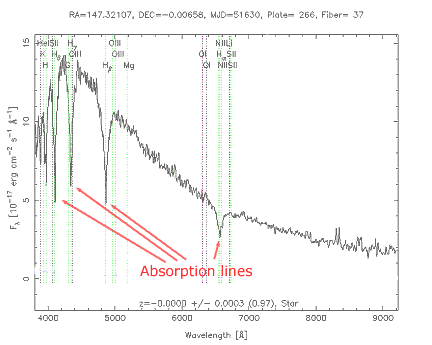
Intensity plot spectrum for a star. Note the absorption lines for the Balmer Series.
Most spectra are now obtained photoelectrically, producing 1D intensity plots like that above. Historically most spectra were obtained photographically. The image below shows a comparison on an intensity plot (or trace) and a photographic plate of the spectrum for the same star.
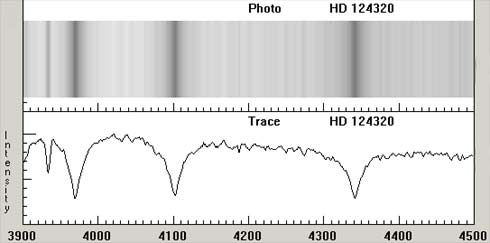
Credit: Adapted from data in Project CLEA The Classification of Stellar Spectra exercise
Comparison of photographic and intensity plot spectra for an A3 V star. The units on the horizontal axis are Ångstroms so this is showing part of the visible waveband.
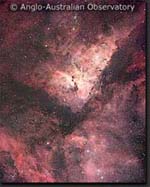
The Eta Carinae emission nebula.
Emission Nebulae
Emission spectra can be observed in emission nebulae such as M42, the Great Nebula in Orion and the Eta Carinae nebula (shown at right). The characteristic pinkish-red colour is called an H II region.
The distinctive colour is due to the spectral line emission when an ionised electron recombines with a proton to form neutral hydrogen. The two spectra below are both of the Eta Carinae H II region. The top one is the original spectra whilst the lower spectrum has been adjusted for sky brightness and the effects of absorption in our atmosphere removed. This spectrum was obtained using IRIS2, an infrared spectrograph on the Anglo-Australian Telescope.
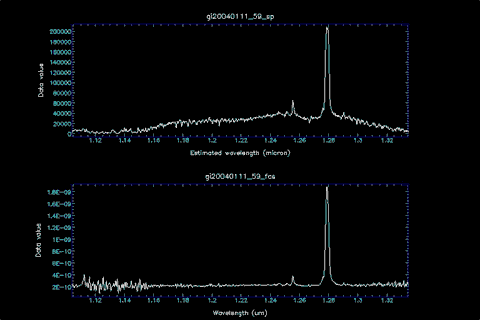
Credit: AAO and Nathan Smith, University of Colorado
Infrared spectrum for Eta Carinae. The top plot shows the raw co-added spectra, and the lower plot is after division by the standard star, flux calibration, and smoothing. The strong line at 1.28 microns is the Pa-beta hydrogen recombination line, while the feature at 1.255 microns is due to [FeII].
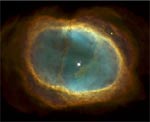
Planetary Nebula NGC 3132
Planetary nebulae are another type of emission nebulae. Their spectra show strong emission features and analysis of the Doppler shift of the lines can be used to determine how fast the ejected gas is expanding. NGC 3132, the planetary nebula shown at right has a diameter of about 1/2 a light year and is 670 pc distant. The shell of gas surrounding the dying star is expanding at about 14 km per second.
Galaxy Spectra
The overall spectrum of a galaxy is simply the combined spectrum of all the stars and other radiating matter in the galaxy. As galaxies vary in structure and relative composition of star type and gas their spectra will vary. The classification scheme for galaxies developed by Edwin Hubble and based on photographic images of the shape of galaxies is now supplemented by comparison of their spectra. Examples of galactic spectra obtained by the 2dF Galaxy Redshift Survey are shown below:
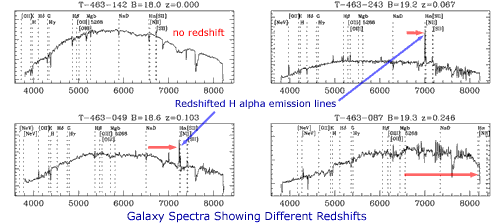
Four different galactic spectra from the 2dF Galaxy Redshift Survey. Note the differing redshifts of the galaxies. The top left galaxy is at zero redshift whilst the bottom right one has a redshift of z = 0.246. The other two galaxies show prominent Hα emission lines suggesting active star formation in them. These Hα lines have been redshifted beyond the rest frame value of 6563 Ångstroms.
Obtaining a spectrum from a galaxy rather than a star differs in that the galaxy can often be resolved as an extended rather than a point-source object. For a galaxy that appears extended it is possible to take a spectrum from different parts of the galaxy. This can provide information such as the composition, star birth rates and the rotational velocity for different parts of the galaxy. Vera Rubin in the early 1970s measured the rotation rate of over 60 galaxies. Her analysis showed that they must have a lot of invisible matter in them to hold them together as they were rotating too fast to be gravitationally bound by the visible mass. The first mention of this so-called dark matter was by Franz Zwicky in 1933. By measuring the velocities of galaxies in the Coma cluster he was able to conclude that about 90% of the mass of the cluster must be some form of dark matter in order to hold the cluster together.
Galaxies have a variety of types. Some are small, dwarf galaxies. Others are giant elliptical galaxies devoid of dust and gas needed for new generations of star birth. Galaxies such as our Milky Way are large spiral galaxies. These typically have several spiral arms around a galactic nucleus. The dust and gas found in the arms can be compressed by density waves that trigger new bouts of star formation. This is commonly seen in H II regions such as M 42, the Great Nebula in Orion and in other galaxies. In the photo of the galaxy NGC 2997 below the H II regions are clearly shown as bright pinkish-red regions in the spiral arms.
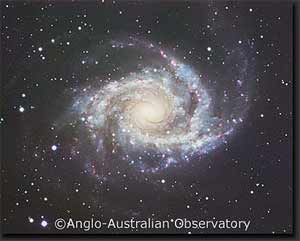
NGC 2997 showing H II regions in the spiral arms.
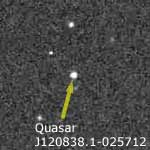
Quasar Spectra
Quasars exhibit very bright emission features relative to a low intensity continuum in their spectra. Indeed it was only through careful analysis of the spectra of quasars that astronomers realised they were not just faint stars. The term quasar is actually a contraction of the term quasi-stellar object or QSO. The image on the right shows a quasar on a field with some stars. It is very difficult to distinguish between them - the quasar appears as a dim star with an apparent magnitude of 18.70.
When the spectrum of the quasar is analysed a few key features are apparent. Firstly, its spectrum shows characteristic strong emission lines rising above a broad continuum. Secondly, the emission lines are not where we would expect to see them if the object was a nearby star. The Lyman α line on the left of the spectrum is formed by transitions between the n = 1 and n = 2 energy levels in neutral hydrogen. This normally produces spectral lines with a wavelength of 121.6 nm or 1216 Ångstroms which is in the ultraviolet part of the spectrum. Here, however, the Lyman α line is clearly seen at a wavelength of about 4,100 Ångstroms in the visible part of the spectrum. Why is this? The standard explanation is that the quasar it at a vast distance from us so appears to be receding from us due to the expansion of the Universe. The high recession velocity of the quasar relative to us means that its spectral lines appear shifted to longer wavelengths. They have been redshifted. The quasar shown has a redshift of 2.3251 as measured from the shift in the lines for this spectrum.
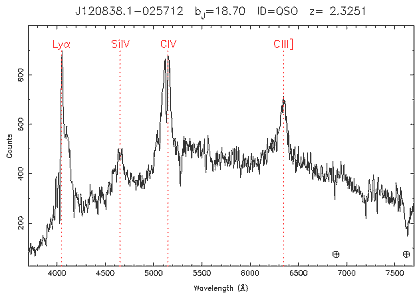
Characteristic QSO spectrum showing distinct, strong, redshifted emission lines.
Exotic Star Types
Some exotic types of stars such as Wolf-Rayet stars exhibit strong, wide emission limes of ionised helium, carbon oxygen and nitrogen in their spectra. These rare, hot and extremely luminous stars are losing mass at a great rate. The emission lines result from a shell of expelled gas expanding at speeds of up to 3,000 km.s-1.
Carbon stars can have similar temperatures to G, K, and M-class stars (4,600 - 3,100 K) but have a much higher abundance of carbon than normal stars. Deep red in colour due to the absorption of blue light by their surface-level carbon compounds, they are assigned a type C spectral class. An example of a carbon-rich star's spectrum is shown below.
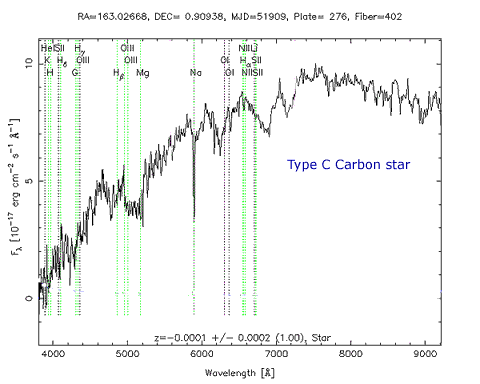
There are other types of exotic stars including Peculiar A stars, Hot Emission-Line stars, and Heavy-Metal-Oxide stars, all of which are classified by their spectra.
brownmenestor1992.blogspot.com
Source: https://www.atnf.csiro.au/outreach/education/senior/astrophysics/spectra_astro_types.html
0 Response to "What Kind of Spectrum Do Astronomers Find Most Useful Emission Absorption Normal Continuous"
Post a Comment